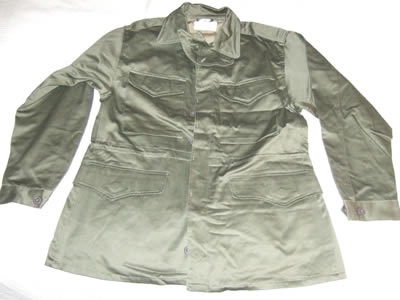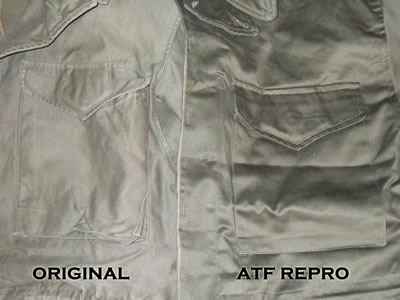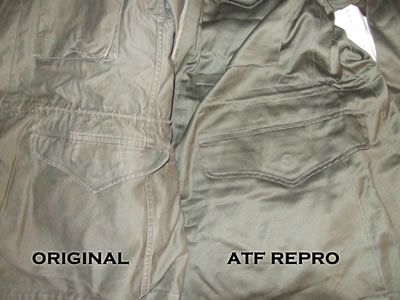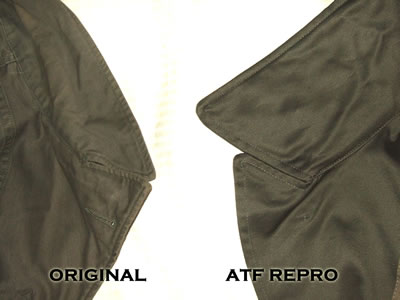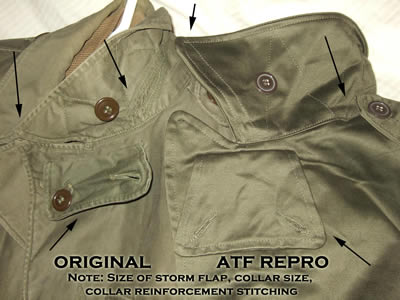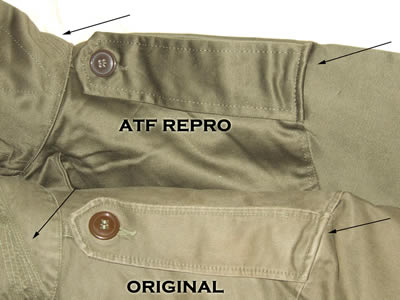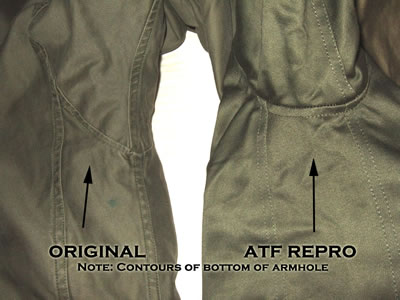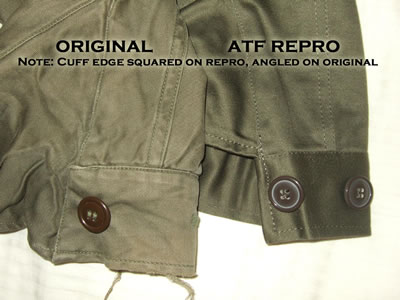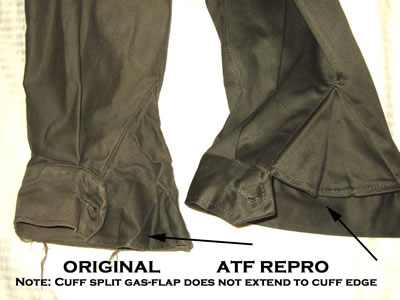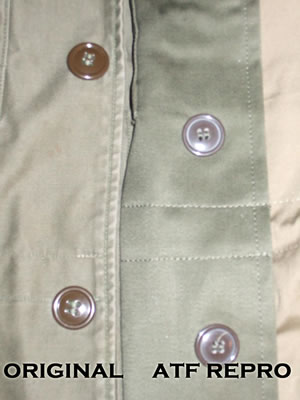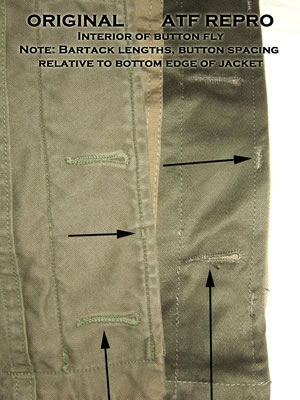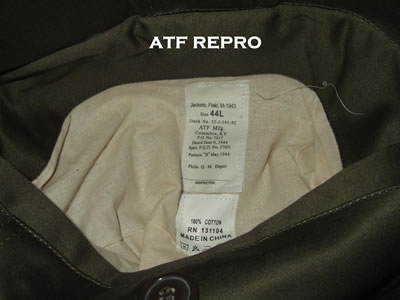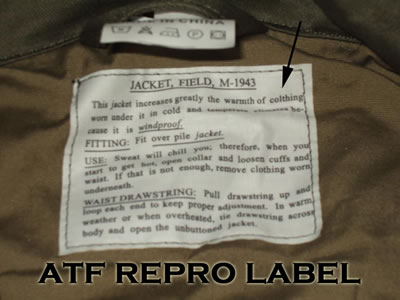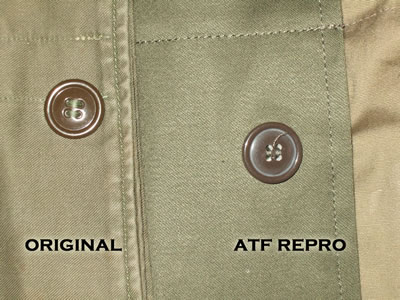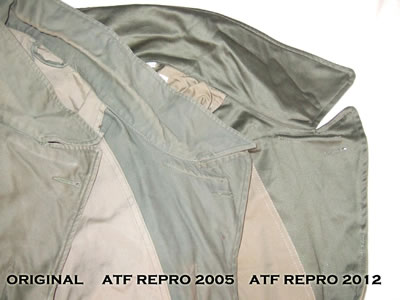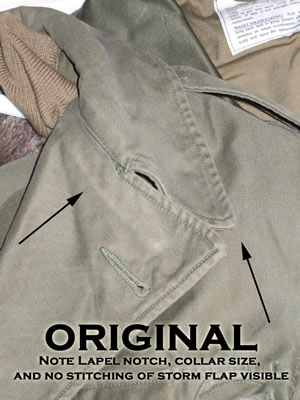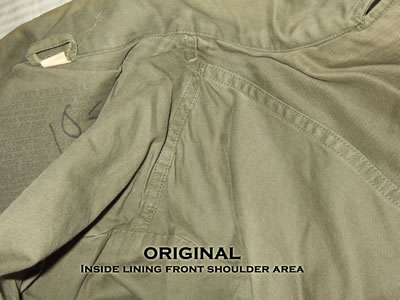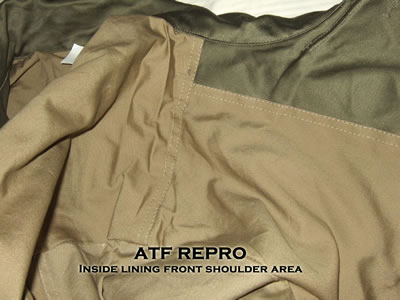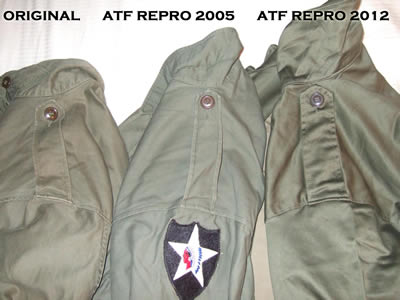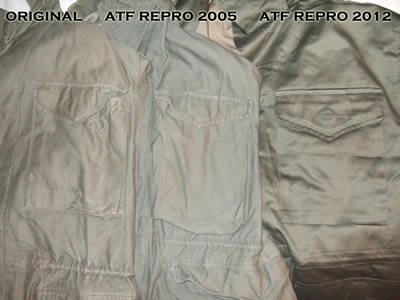At The Front M43 Field Jacket
Review Date: 8/5/2012
Author: Sean Foster
Ignoring the dead body of a German soldier and knocked out nazi tank in the background, American Infantrymen don their new issue of the new type of combat jacket designed for warmth. They are in the La Salle sector of France.
157th Infantry Regiment, 45th Infantry Division
Location: France Date taken: October 31, 1944 Photographer: Harris, Signal Corps. Courtesy of the National Archives and Records Administration
Background:The M-1943 Field Jacket (Jacket, Field, M-1943) was the result of research and development to adopt an all-purpose uniform that would allow for ease of issue to American military forces. Prior to the adoption of the M-1943, there were specialized uniforms for paratroopers, mountain troops, ski troops, armor crew, etc. The numerous special garments added distinction and sometimes a certain esprit de corps, however the logistics of production, procurement, and issue proved to be an added complication which was not helpful in time of world war and fabric rationing on the homefront. The M43 field jacket was well received by the troops, and many of its foundational design elements remain in use in military field jackets of numerous nationalities to this day.
The M1943 Field Jacket was the primary garment of the layering system which also included the pile liner and field trousers. The garment itself was oversized to allow its wear over the following other garments, given the need: Undershirt, OD wool shirt, sweater, pile liner. As a result, an original marked 38L can easily fit someone size 44L when not being worn over a sweater and pile liner. These were issued in even numbered chest sizes and in varied heights. In personal experience I have seen these ranging in size from 32R to 48L. 36R seems to have been one of the most common sizes produced.
Issue of the M43 field jacket seems to become widespread beginning in October 1944 and increasing through the end of the war. Some soldiers in the MTO received these jackets as part of QMC trials in 1943. Once adopted, a deliberate effort was made to have these jackets produced and issued to the soldiers, even though the other garments of the M1943 system (field cap, pile liner, field trousers) were scarce during the war due to the concentrated emphasis on getting the field jacket produced and issued. During the Korean War, this field jacket had become the standard field jacket for the Marines as well as the Army. It was subsequently replaced by the M-1951 and later the M-65 field jacket.
Ordering:
Purchase date: July 31, 2012
Delivered: August 02 2012 (Returned August 03 2012)
Current Retail: July 31, 2012: $99.99
At $100, this is reasonable and about the same price I paid for my earlier ATF M43 field jacket in 2005. Other vendors sell repro M43 field jackets in the range of $70 to $220, with the more expensive ones being made in the USA. When looking at the garment from a apparel design and construction standpoint, it is my honest opinion that it could not be manufactured in the USA for the price ATF is selling it for (and indeed, this garment is made in China). The design is a complex one to manufacture when compared with other field jackets like the M1941 or the tanker jacket.
About the Comparison:
Size purchased: 44L
Original size: 38L
* In some images I have also included a 2005 production ATF repro M43 field jacket, size "L"*
Materials:
The shell fabric as well as the lining material compare well to originals. The fabric is tightly woven, as it should be. Since I returned the jacket I am not able to test its appearance after getting it wet to allow for normal shrinkage. I have no objections concerning the cloth materials used. The buttons are not exact copies, but they are reasonably close.
Sizes:
These are made in even numbered sizes (40, 42, 44, etc) which is how the originals were made. Some sizes are available in Long (tall) height. Older ATF repros (like the one I use in some comparison images below) were made in size ranges (Medium, Large, X-Large, etc) and this is not how originals were sized.
Patterning:
This is where this garment fails to meet my standards, and the reason I returned it. In general, the garment looks like a M43 field jacket from a distance, but closer examination reveals the details of patterning were incorrectly done. Certain aspects of the pattern must be graded to larger and smaller sizes to conform to the general appearance. However on the originals, some features were not graded larger equivalent relative to others.
In this case, the collar is the primary feature which has been graded much too large for the garment. These images show how the collar has increased in size (width) far beyond where it should be. On every original I can recall, and on those I can see images of, the collar extends out only about as far as the lapel (when laid flat and open). This one has a noticeably larger collar. It may not be very noticeable when worn open collared, but when buttoned up it is clearly too large.
Also, under the left lapel, the storm flap is also oversized, presumably to conform to the wide collar. It makes this feature difficult to conceal under the lapel as on the original.
Underneath the collar, the reinforcement stitching is located further to the back than on the original.
The epaulettes also appear to have been widened. The tip of the epaulette is not as angled/pointed as the original.
Possibly due to increased sizing, the contours of the armholes are different. The original shows a shaped armhole, less round and more oval.The current repro is very round and more similar to modern patterning where there is more emphasis on comfort fit and less emphasis on appearance. In general I accept this as it is not overly obvious when worn, however there is a difference in how the sleeve looks. This is a compromise to offer larger sleeves for those with larger shoulders and upper arms. The originals are slimmer fitting in the sleeve (and not only due to the size difference). There is more curvature in the panels of the sleeve, and the body panels around the armhole on the original. This is not a detail I expect to be copied using modern mass-production however it is as easily added as left out. The resulting sleeves on this repro are large and spacious, and this can make them look wrinkled on someone without large arms to fill them out.
The cuffs do not have the gas flap panel extend to the bottom of the cuff, however I have seen one or two originals made this way. The original used for this comparison is different.Also the side of the cuff where the buttons are added is squared on the repro, but angled on the original. The cuff band itself is shorter in height to an original, and one would think this measurement would actually increase when patterned larger, not decrease.
Button spacing is a bit different as on originals the bottom button is much closer to the bottom edge of the jacket. On this repro, the bottom button is further up on the front. Other spacing discrepancies result from the change in reference point for this bottom button.
The fly front has bartack stitches to keep it flat and closed and protect the buttons (and prevent buttons from catching on brush etc). The bartack stitches on the repro are the usual length of about 3/8 to 1/2 inch. The original ones are much smaller, about 3/16 to 1/4 inch, and this means the original is easier to button as there is more space allowed to get your fingers into the fly to button the garment.
Details:
The contract label in the pocket is well done, and the import tags appear to be easily removed. The size tag in the neck resemble originals as well.
The instruction label in the inside back neck is well done apart from one 'Engrish" typo: 'colthing' instead of 'clothing'.
Thread used to secure the buttons is modern thin synthetic, and does not have the thickness of the thread used to secure originals. This is a similar problem to nearly every repro M43 jacket I have personally examined in recent years.
Waist draw-cord opening holes lack the reinforcement stitched inside as seen on originals. This makes these opening holes more prone to ripping open.
Original epaulettes cut with a definite front and back, as the long side closest to the rear is longer than the front side. The repro is cut symmetrical.
The storm flap is secured on the repro by stitching it through the finished lapel (see visible stitching on lapel face). Originals did not have this stitching visible, as it was secured to the lapel before the lapel face was finished. This same error existed on the 2005 ATF repro.
Construction:
The garment is well made and I did not find any missing stitches, or any seams not properly sewn together. Stitching arrangement (single needle seam / double needle seam) is accurately replicated on the repro.The garment appears as though it will be durable, my only suggestion for improvement in construction is to secure the buttons with thicker thread.
Other repros:
Other repros I have owned I have subsequently sold off, apart from an older (2005) ATF model and a SEMS made repro (sold a few years ago by Hessen Antique). I made comparison photos with the 2005 ATF model, as I cannot understand why some changes made in this new model were done more correctly in the older offering. In my opinion, the older one was a better garment, even though it was not offered in specific chest sizes. The SEMS repro (not pictured) is, in my opinion, the best repro one currently in my possession (even though its coloration is not as good as the ATF ones, its patterning is better). I do not believe WPG has offered an M43 jacket since around the time that ATF introduced their first one around 2004/2005.
Conclusion:
I returned the new ATF M1943 field jacket the day after I received it. I briefly considered how I could 'defarb' it as I had done with their repro M43 pile liner, but in the end it was easiest to return it and wait for a better repro to become available. I suppose one could have a tailor modify the collar to a smaller width, and this would solve most of the noticeable discrepancies. I must admit I was perplexed at the actual garment, after having read the very promising item description on the ATF website. I know batches of repros can vary, and those who contract to make repro garments place a lot of investment at stake when making them. As a general trend I expect progressive improvement in the products offered. I honestly cannot understand how this repro did not build upon the strengths of their older pattern. Instead, by starting from scratch they ended up making something less accurate than what they offered seven years ago.
90th IDPG Reviews




